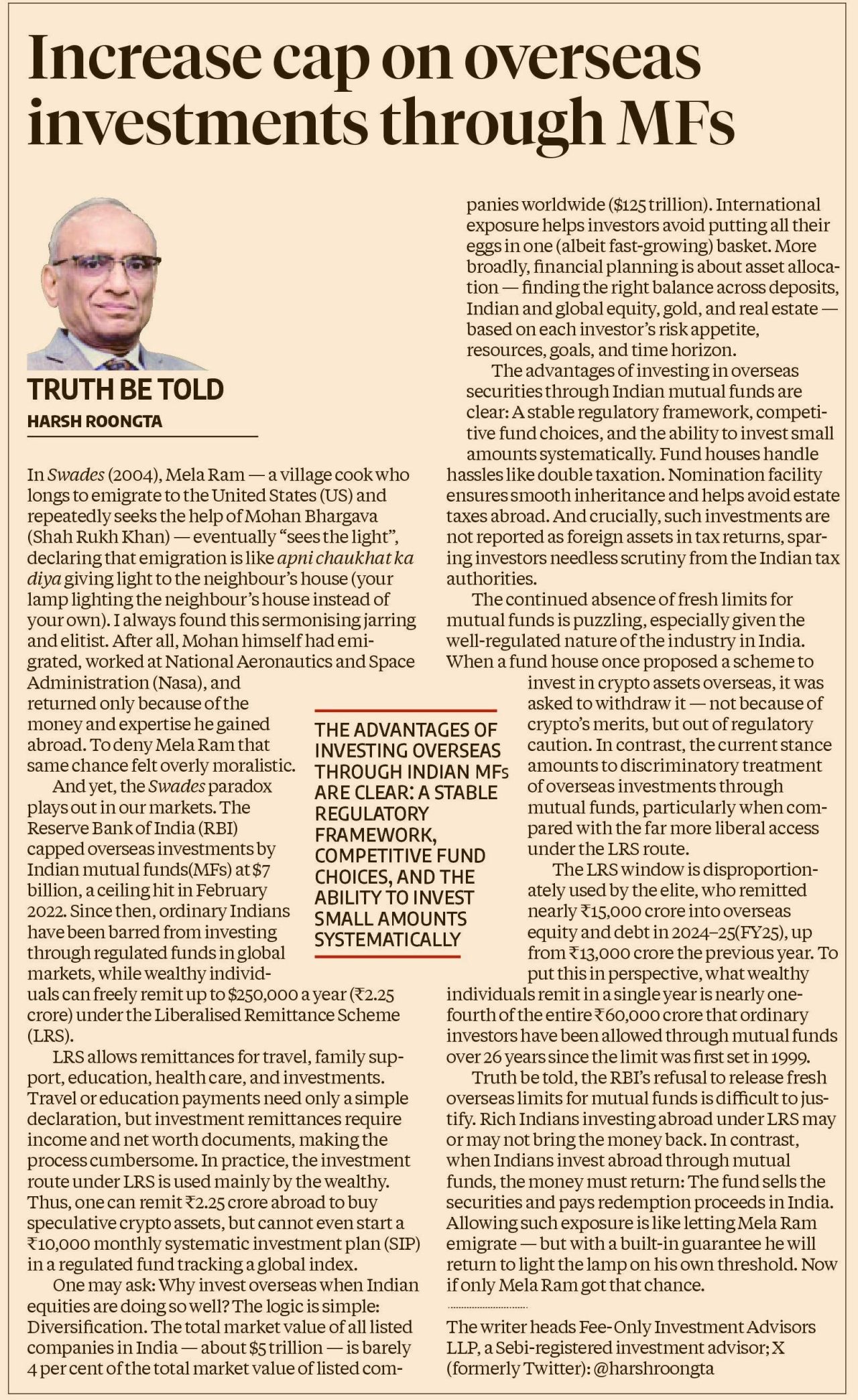
In Swades (2004), Mela Ram a village cook who longs to emigrate to the United States (US) and repeatedly seeks the help of Mohan Bhargava (Shah Rukh Khan) eventually sees the light, declaring that emigration is like apni chaukhat ka diya giving light to the neighbours house (your lamp lighting the neighbours house instead of your own).
I always found this sermonising jarring and elitist.
After all, Mohan himself had emigrated, worked at National Aeronautics and Space Administration (Nasa), and returned only because of the money and expertise he gained abroad. To deny Mela Ram that same chance felt overly moralistic. And yet, the Swades paradox plays out in our markets.
The Reserve Bank of India (RBI) capped overseas investments by Indian mutual funds(MFs) at $7 billion, a ceiling hit in February 2022. Since then, ordinary Indians have been barred from investing through regulated funds in global markets, while wealthy individuals can freely remit up to $250,000 a year (₹ 2.25 crore) under the Liberalised Remittance Scheme (LRS). LRS allows remittances for travel, family support, education, health care, and investments.
Travel or education payments need only a simple declaration, but investment remittances require income and net worth documents, making the process cumbersome. In practice, the investment route under LRS is used mainly by the wealthy.
Thus, one can remit ₹ 2.25 crore abroad to buy speculative crypto assets, but cannot even start a ₹ 10,000 monthly systematic investment plan (SIP) in a regulated fund tracking a global index. One may ask: Why invest overseas when Indian equities are doing so well? The logic is simple: Diversification.
The total market value of all listed companies in India about $5 trillion is barely 4 per cent of the total market value of listed companies worldwide ($125 trillion).
International exposure helps investors avoid putting all their eggs in one (albeit fast-growing) basket.
More broadly, financial planning is about asset allocation finding the right balance across deposits, Indian and global equity, gold, and real estate based on each investors risk appetite, resources, goals, and time horizon. The advantages of investing in overseas securities through Indian mutual funds are clear: A stable regulatory framework, competitive fund choices, and the ability to invest small amounts systematically. Fund houses handle hassles like double taxation.
Nomination facility ensures smooth inheritance and helps avoid estate taxes abroad. And crucially, such investments are not reported as foreign assets in tax returns, sparing investors needless scrutiny from the Indian tax authorities. The continued absence of fresh limits for mutual funds is puzzling, especially given the well-regulated nature of the industry in India.
When a fund house once proposed a scheme to invest in crypto assets overseas, it was asked to withdraw it not because of cryptos merits, but out of regulatory caution. In contrast, the current stance amounts to discriminatory treatment of overseas investments through mutual funds, particularly when compared with the far more liberal access under the LRS route.
The LRS window is disproportionately used by the elite, who remitted nearly ₹ 15,000 crore into overseas equity and debt in 202425(FY25), up from ₹ 13,000 crore the previous year. To put this in perspective, what wealthy individuals remit in a single year is nearly onefourth of the entire ₹ 60,000 crore that ordinary investors have been allowed through mutual funds over 26 years since the limit was first set in 1999.
Truth be told, the RBIs refusal to release fresh overseas limits for mutual funds is difficult to justify.
Rich Indians investing abroad under LRS may or may not bring the money back. In contrast, when Indians invest abroad through mutual funds, the money must return: The fund sells the securities and pays redemption proceeds in India. Allowing such exposure is like letting Mela Ram emigrate but with a built-in guarantee he will return to light the lamp on his own threshold. Now if only Mela Ram got that chance.
The writer heads Fee-Only Investment Advisors LLP, a Sebi-registered investment advisor; X (formerly Twitter): @harshroongta
the advantages of investing overseas through indian mfs are clear: a stable regulatory framework, competitive fund choices, and the ability to invest small amounts systematically
TRUTH BE TOLD harsh roongta
Disclaimer: These are personal views of the writer. They do not necessarily reflect the opinion of www.business-standard.com or the Business Standard newspaper
(A slightly different version of this column first appeared in the Business Standard on August 25, 2025)
